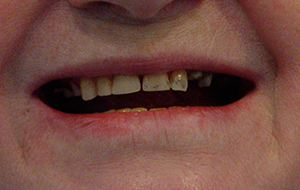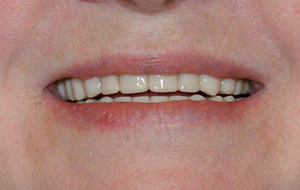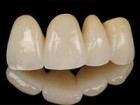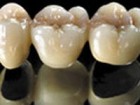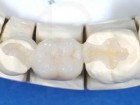Dentures
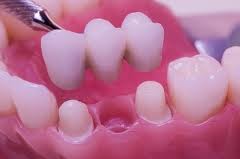
Dentures help solve the problem of missing teeth.
Dentures - a structure consisting of two crowns between which there are artificial teeth.
The denture resembles a bridge in shape.
The structure of the bridge structure: the supporting part (crowns on the supporting teeth) and the intermediate part (body of the bridge).
Types of bridges
- A traditional bridge consists of two crowns and an intermediate part.
- Bridge prostheses with one-sided support (cantilevers) are installed with adjacent teeth on only one side.
- The Maryland bridge is made of plastic and is supported by a metal frame on the abutment teeth.
- Cast bridges.
- Bridge prostheses with pressed stamped crowns.
- Bridge structures made of plastic.
- Ceramic bridge
- Combined bridges.
- Ceramic-metal dentures.
- Metal-plastic bridges.
- Bridge prostheses on lock fastenings.
- Adhesive denture.
- Bridge prosthesis on implants.
- Composite reinforced bridges.
The choice of denture depends on factors:
- bite features;
- location of the defect;
- tooth and gum conditions.
Often the decisive factor is the financial one.
Metal-plastic bridges
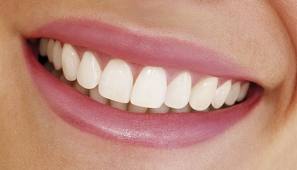
- A metal-plastic prosthesis is a metal structure designed for one or more teeth coated with a composite plastic.
- The advantage of a prosthesis made of metal-plastic is that its hardness is comparable to the hardness of real teeth.
- Metal plastic, in contrast to cermets, in contact with real teeth does not lead to their abrasion.
- Composite plastic is very firmly attached to the metal under the influence of light radiation. Due to this property of metal-plastic, restoration of a destroyed crown or prosthesis can be performed directly in the oral cavity without removing them from the teeth.
Glue bridge
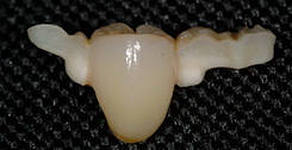
The glue bridge (adhesive) is one of the most modern and promising types of dentures, which allows you to install the tooth on glass supports.
The advantages of this technique:
- the ability to restore teeth in one visit;
- a small portion of the enamel of a healthy tooth is prepared to attach a fiberglass tape;
- the cost of an adhesive bridge is approximately half the cost of a ceramic-metal prosthesis;
- no turning and depulping of healthy teeth is required.
Indications for the installation of a bridge
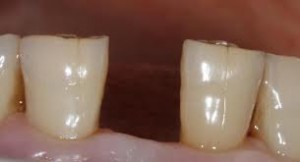
- Lack of one and several teeth;
- defects in the teeth and dentition, if there is no way to eliminate them in other ways;
- replacement of bridges;
- defect associated with the absence of 2 teeth.
Contraindications:
- bruxism (involuntary grinding of teeth);
- clinical case: with the loss of three extreme teeth;
- with malocclusion;
- pathological abrasion of teeth;
- periodontal disease and periodontitis.
Preparation steps
Dental prosthetics with bridges are as follows:
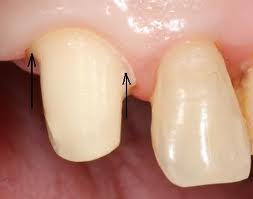
- Patient's visit to the dentist.
- Planning or preparing for prosthetics.
- Turning and, if necessary, tooth removal.
- Taking casts.
- At the time of manufacture of the permanent structure, temporary bridges are installed.
- Installation and fixation of the finished prosthesis.
Stages of the preparation of teeth:
- After preparation for prosthetics, the doctor grinds the supporting teeth.
- A layer of enamel of such thickness as the crown will have is removed from the teeth. The tooth is attached to a shape convenient for fixing the denture, in the area of the neck of the tooth make ledges.
- If necessary, teeth are pulped.
Stages of manufacturing a prosthesis
- Taking impressions from the jaw. Making a model of the jaw with plaster teeth.
- On such an individual model, the dental technician forms the frame of the future prosthesis.
- Fit the skeleton of the bridge to the teeth.
- Taking casts for the body of the structure. To do this, use wax.
- Selection of material for facing the frame.
- Cement installation and fixation on abutment teeth using cement
Video: Making a bridge
Bridge Care
Dentures and adjacent gums should be cleaned with:
- Toothbrushes with paste. It is necessary to brush with sweeping movements from the gums to the chewing surface of the teeth.
- Brushes - brush with toothpaste, in order to clean the bottom of the prosthesis.
- Dental floss (floss) with paste, for polishing the back surface and sides of the facet.
- It is recommended to use special solutions for rinsing the oral cavity.
- The ability to directly visualize cracks or secondary caries.
- Facilitate access to root canals.
- Preservation of the design, which eliminates the need for its re-manufacturing.
- Addiction to bridges is faster than to removable dentures.
Bridge removal
The removal of the bridge is done if there is a suspicion of a crack or leaching of cement.
The ability to remove the structure has several advantages:
- The removal of bridges should be discarded if it is not known what type of cement was used during installation.
- Before removing the bridge, the pros and cons are evaluated.
Removing the bridge for the purpose of its further use is undertaken in the following cases:
- If necessary, keep the prosthesis;
- If you suspect a crack or fracture of the tooth;
- With signs of erosion of cement;
- If the stump of the tooth crown is stable enough.
Possible mistakes
Errors in prosthetics are often made in cases where the requirements for the installation of dentures are not met.
Common errors with prosthetics with bridges:
- Lack of indications for the installation of a bridge.
- The use of porcelain for the manufacture of a prosthesis without taking into account the condition of the bite. Such prostheses have to be replaced with a structure made of another material.
- The presence of pathology in the oral cavity and the lack of full rehabilitation.
- Incorrect casting, which entails a deepening of the edge of the crown under the gum. This position of the crown leads to the occurrence of gingivitis. In this case, the prosthesis should be changed.
- Careless manufacturing of a prosthesis.
- Prolonged prosthesis fabrication. An inflammatory process in the periodontium may develop.The process of destruction of turned teeth is accelerated when their crowns are not covered.
- Wrong choice of material for prosthetics.
To avoid errors, prosthetics is best done only in specialized dental clinics.
Video: Damage to the bridge
Life time
Bridges have a lifespan of 5 to 15 years or more.
How many bridge structures actually serve depends on the following factors:
- quality and quantity of supporting teeth;
- periodontal conditions;
- length of construction;
- uniformity of the load on the prosthesis when chewing. When chewing only on the side of the bridge, its service life is reduced.
After 5 years of using the design, you need to pay attention to:
- the presence of mobility of the prosthesis;
- the condition of the gums of the abutment teeth: bleeding, the presence of swelling, exposure of the neck of the tooth;
- the condition of the gums under the artificial teeth of the bridge: the presence of redness, bleeding;
- the condition of the gums between the teeth and crowns: their redness, enlargement, bleeding, does food get between the crowns and teeth;
- you can make an x-ray of the supporting teeth so that the doctor can assess the condition of the teeth themselves and periodontal tissues.
If you follow the hygienic care of the oral cavity and undergo regular examinations, then the service life of bridges can last up to 15 years and longer.
Photo: before and after the installation of the bridge
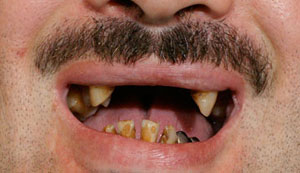 |
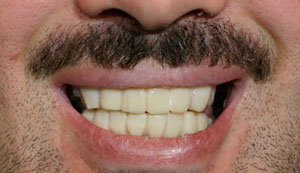 |
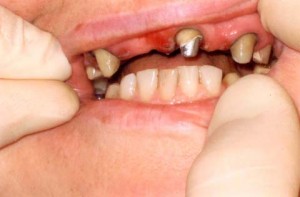 |
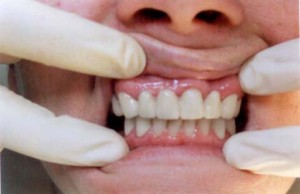 |
Cost
The price of the bridge depends on the type of bridge being installed, the material and the installation location.
How much does it cost to install a bridge?
The approximate cost of bridges:
| Type of prosthesis | Cost for 1 Unit (crown) |
| Individual facet bridge | 2000 rubles |
| Ceramic metal bridge | 3500 rubles |
| Ceramic bridge (zirconia) on the front teeth | 10,000 rubles |
| Plastic Dentures | 1000 rubles |
| Bridge prosthesis with support on tabs and floor crowns | 5500 rubles |
| Adhesive bridge | 1500 rubles |
| Ceramic bridge | 45,000 rubles |
| stamped bridges | 1000 rubles |
| Facet crown | 1500 rubles |
| Implant-supported bridge | 10,000 rubles |



